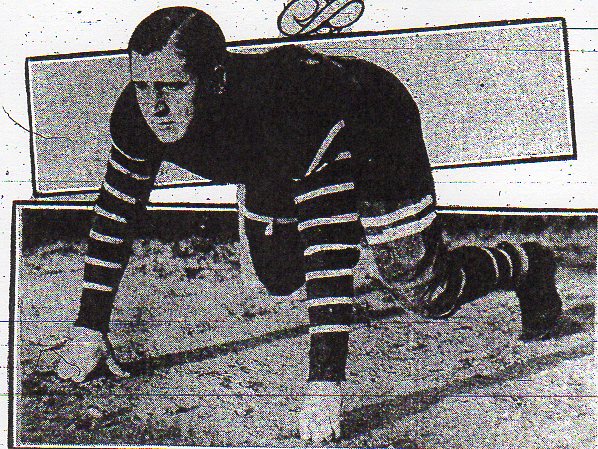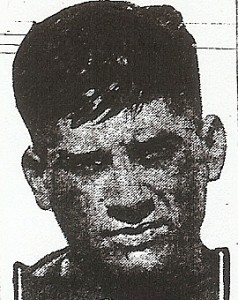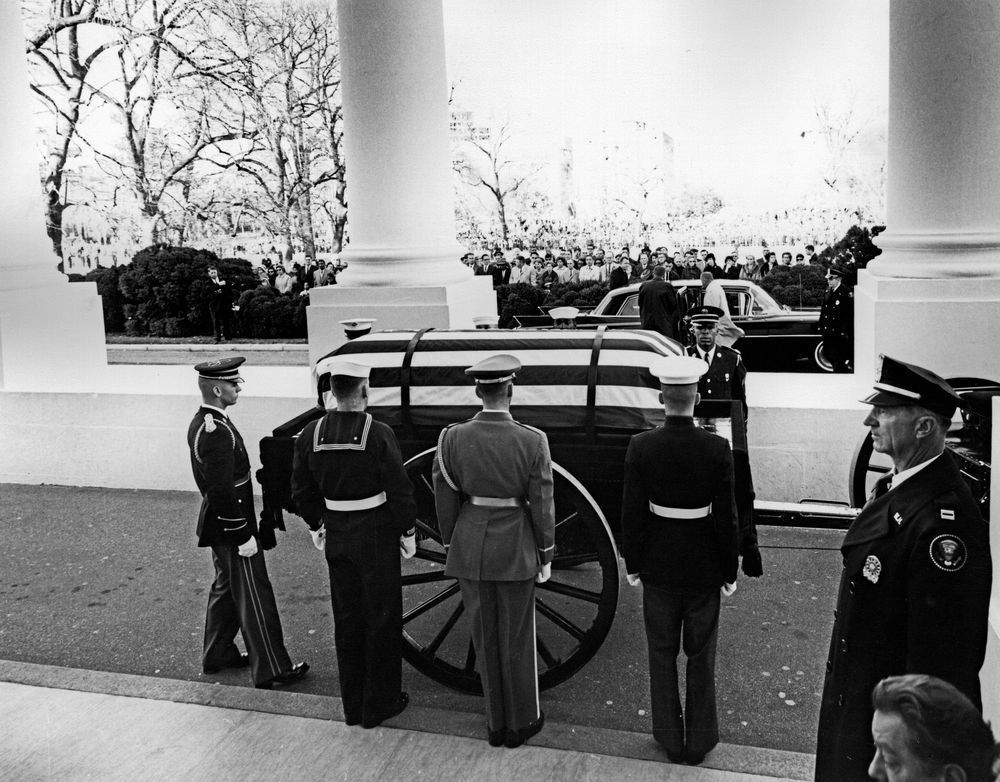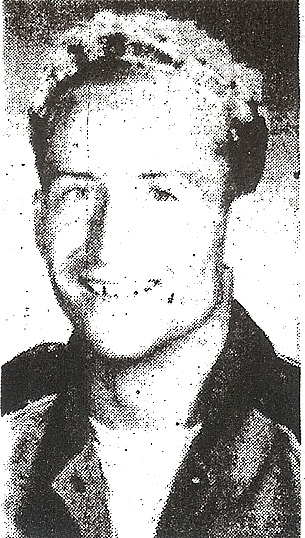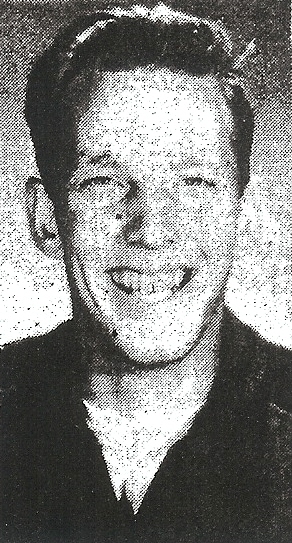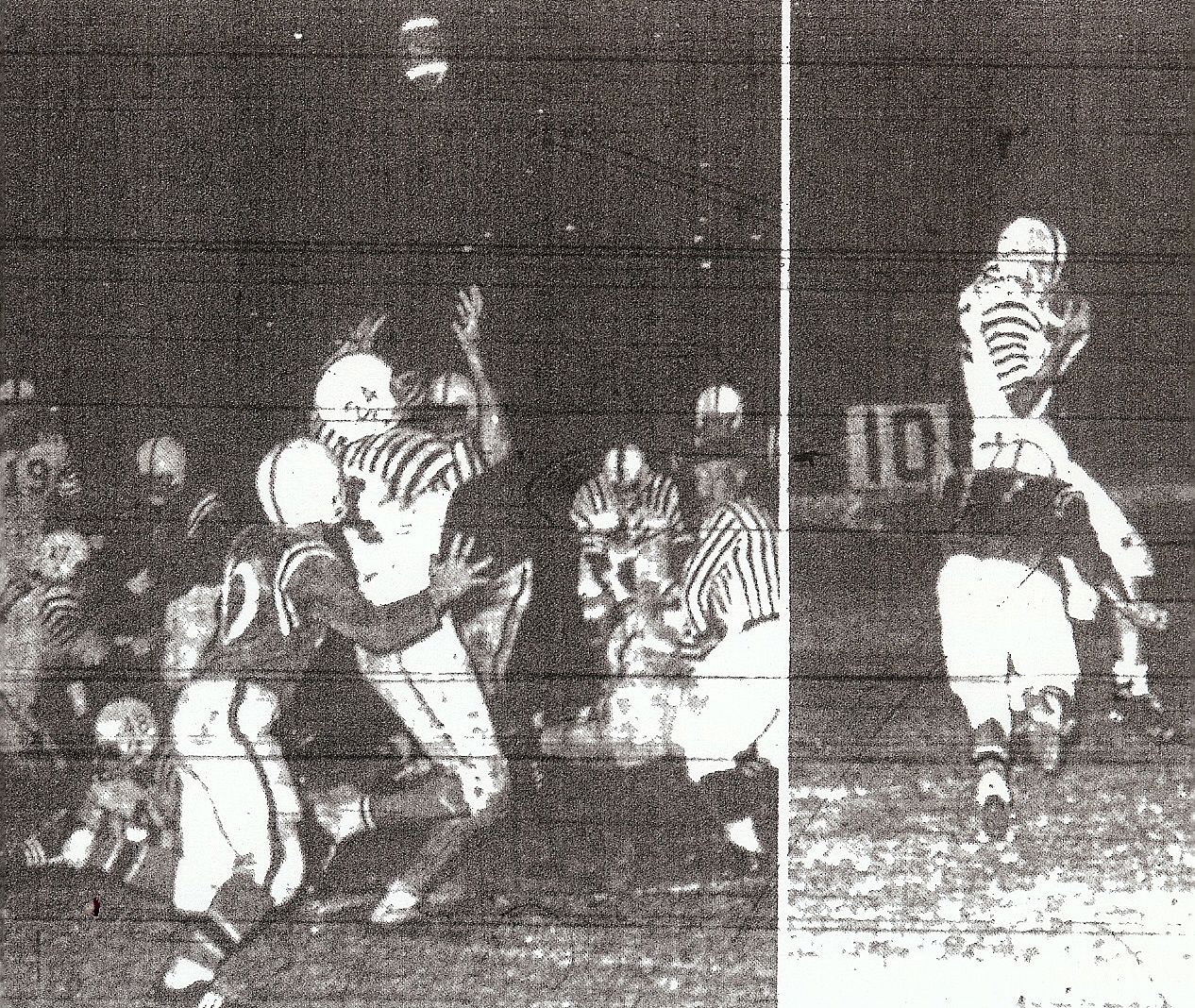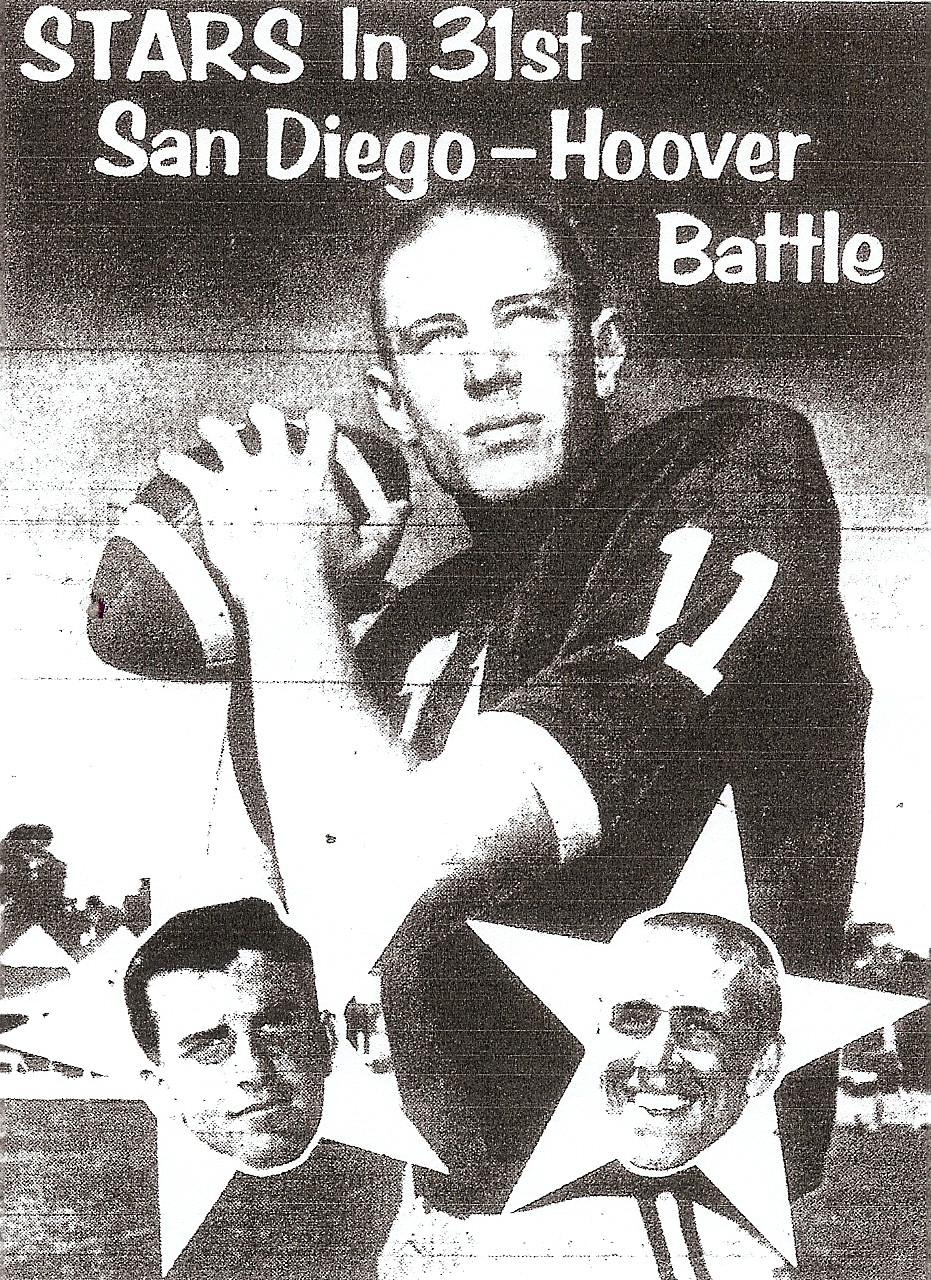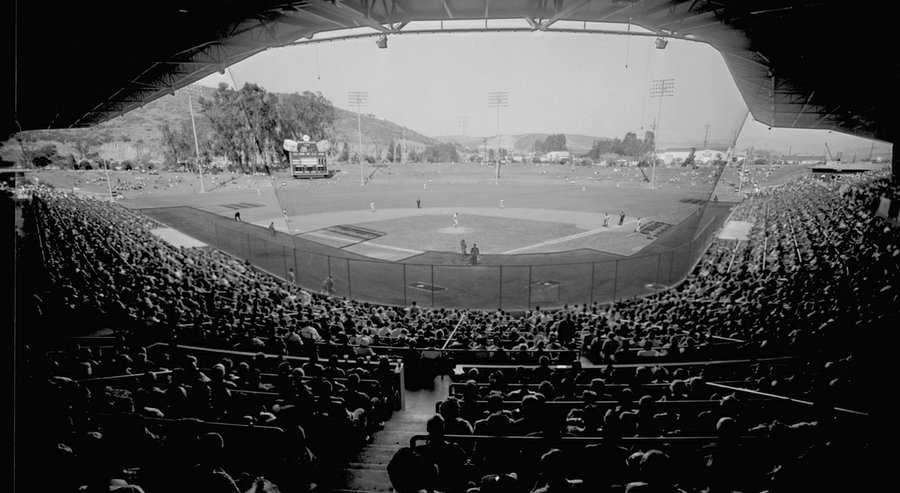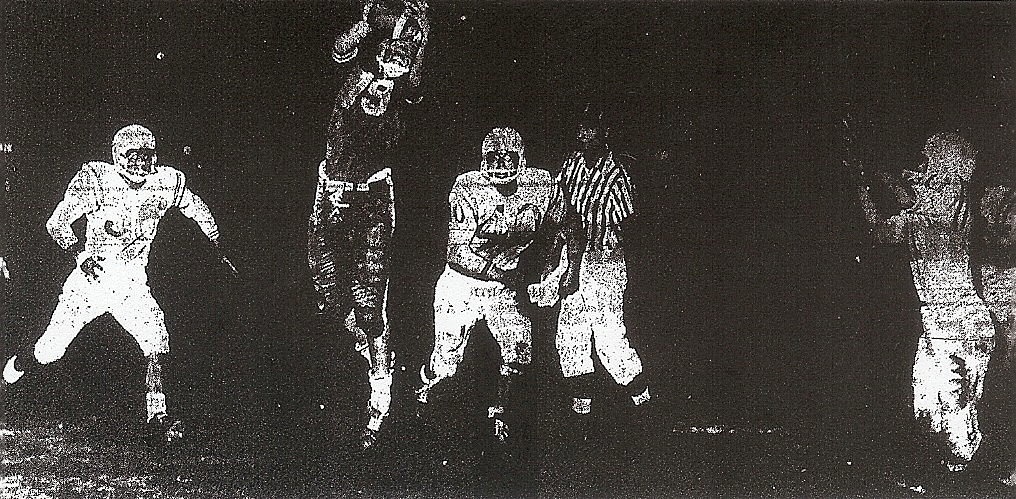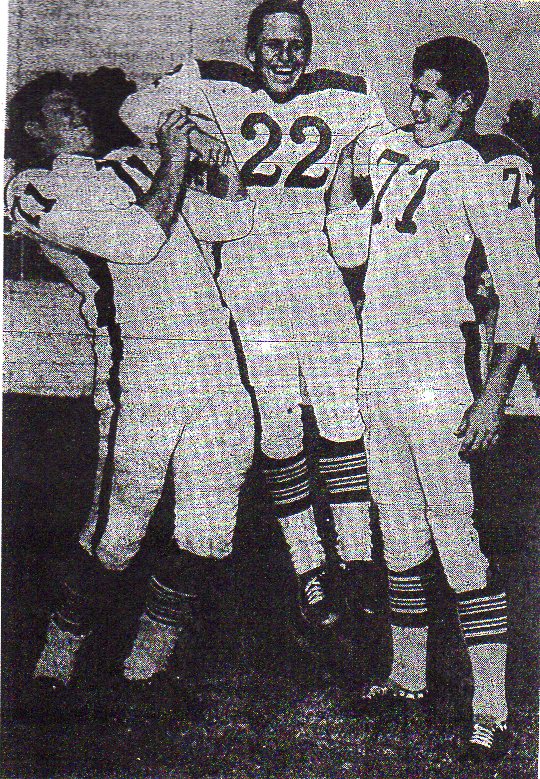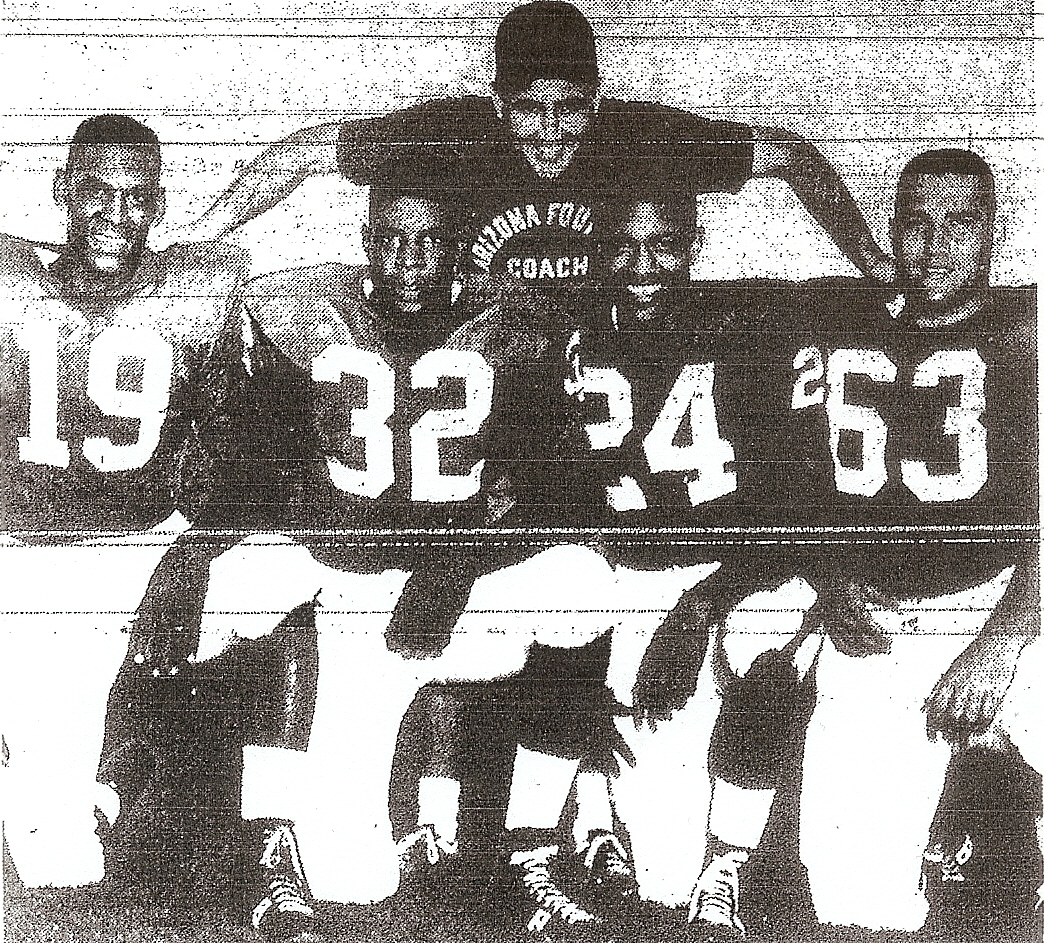1920: Hilltoppers Set Record With 130 and “New” Grossmont Arrives
Army-Navy had a 5-0 record. San Diego High (4-1) had just been run off the field, 51-0 by the 5-0 Long Beach Poly Jackrabbits.
Did Army-Navy have a chance the following week against the Hilltoppers and their 24-year-old, rookie head coach, John Perry.
No.
Perry addressed a school assembly the day before his team would meet coach Paul Jones’ Cadets.
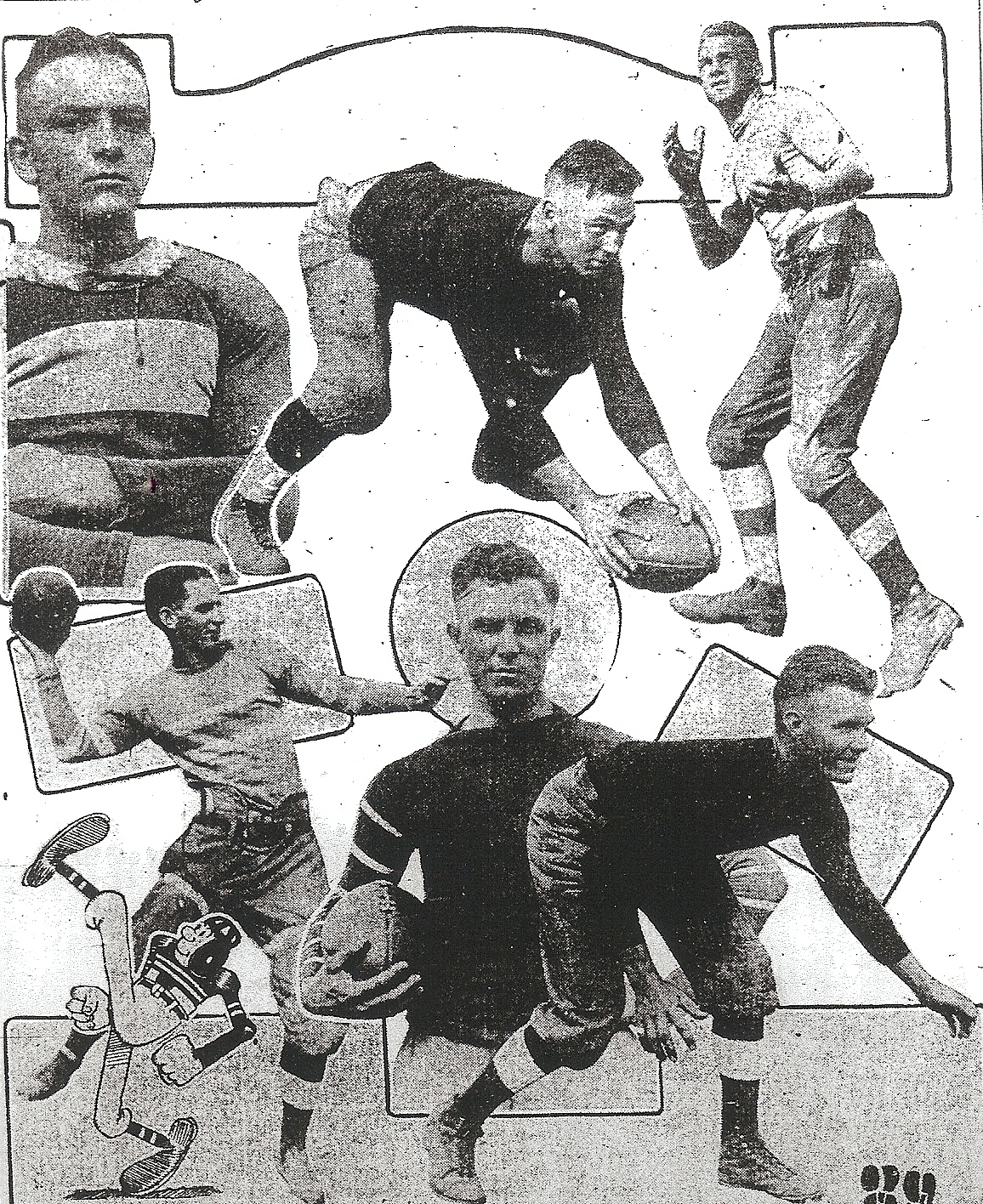
Perry said no team in the United States could beat San Diego by the score Long Beach had mustered and that was by a fluke, which the writer of the story did not reveal and which begged the question, how could a 51-point loss be determined “by a fluke”?
“Furthermore,” said Perry, “San Diego is still in the running (for the Southern California championship) and with the addition of new forms of offensive and defensive playing, we expect to take a little revenge on the innocent Army-Navy men.”
Certainly not the coach talk of later years. If Perry actually was quoted accurately or felt some pressure and was nervously boasting to the school assembly, or the writer’s imagination was in overdrive, or both, Perry’s words rang true.
The Hilltoppers rained 19 touchdowns on their outmanned opponents.
Although a touchdown by Army-Navy’s Brick Crowell tied the game, 7-7, the score was 26-7 after one quarter, 75-7 following a 49-point second quarter, and 103-7 after three.
The final count, 130-7.
POURING IT ON?
Did Perry run up the score?
His squad numbered only 24 with just a handful of reserves. The teams played 15-minute quarters and rules of the day meant that Army-Navy kicked off after each touchdown.
San Diego’s John Hunter scored 7 touchdowns and added 15 points after for 57 points. Nine other Cavemen scored touchdowns.
The only team in state history to score more points in one game was Santa Rosa in a 141-0 victory over St. Helena in 1924.
To prevent such runaways CIF sections decades later installed “mercy’ rules and running clocks, usually when one team was ahead by 40-45 points.
Hunter’s point total was bettered in San Diego County only by the 80 points Coronado’s Frank (Toady) Greene scored in a 108-0 victory over Sweetwater in 1929.

PRE-PRACTICE MANTRA
A story with no byline in The San Diego Union captured the youthful Perry’s approach when he addressed his football candidates in the San Diego High auditorium at their first meeting Sept. 3, 1920.
“We want to get the spirit of 1920 this season,” said the coach. “We’ve heard too much about the spirit of 1916. It’s getting a little old. We must forget those victories and win others.”
Other remarks by Perry:
“At 4 p.m. next Tuesday I shall call the roll of the first squad. Coach (A.E.) Shaver and Captain (Lawrence) Hall will do the same for the second and third squads.”
“Any man absent without a good excuse for two successive nights will have to turn in his uniform. We have too many out for work to bother with shirkers.
“And furthermore, you fellows keep up in your studies, They’re the big thing as football is the big sport. You can understand me when I say the fellow with all brawn and no brains is no football player.
“Three things you must have for football: obedience, aggression, and concentration. With this goes about sixty per cent fight. It’s the fellow with fight and brain who makes the great player.”
EASY DOES IT
Union headline on Sept. 24: “Scrimmage Hard on Hilltop Boys; Five Knocked Out”.
Apparently Howard Williams, Ed Rawlings, Fred Manning, Gerald Snyder, and Harold (Hobbs) Adams “were taken unconscious from the fray”, an intrasquad scrimmage before the season opener against Sweetwater.
Williams is reported to having returned, “but collapsed at the end of practice”, and may not play in the opener.
Hard to believe, but flimsy helmets and pads offered little protection..
NEW SCHOOL, OR NOT?
Grossmont High opened this year, located on what was known as the Riverview campus in Lakeside.
It would be two years before the school moved to the top of the Grossmont Summit in La Mesa, where it sits today overlooking the El Cajon Valley.
But was Grossmont really a new school in 1920?
On the school’s 90th anniversary in 2010, “The Fountain of Hope” was remembered in a campus publication:
“The class of 1916 donated a drinking fountain made of granite from a local quarry to the old El Cajon Valley Union High School and inscribed ‘Class of 1916’”.
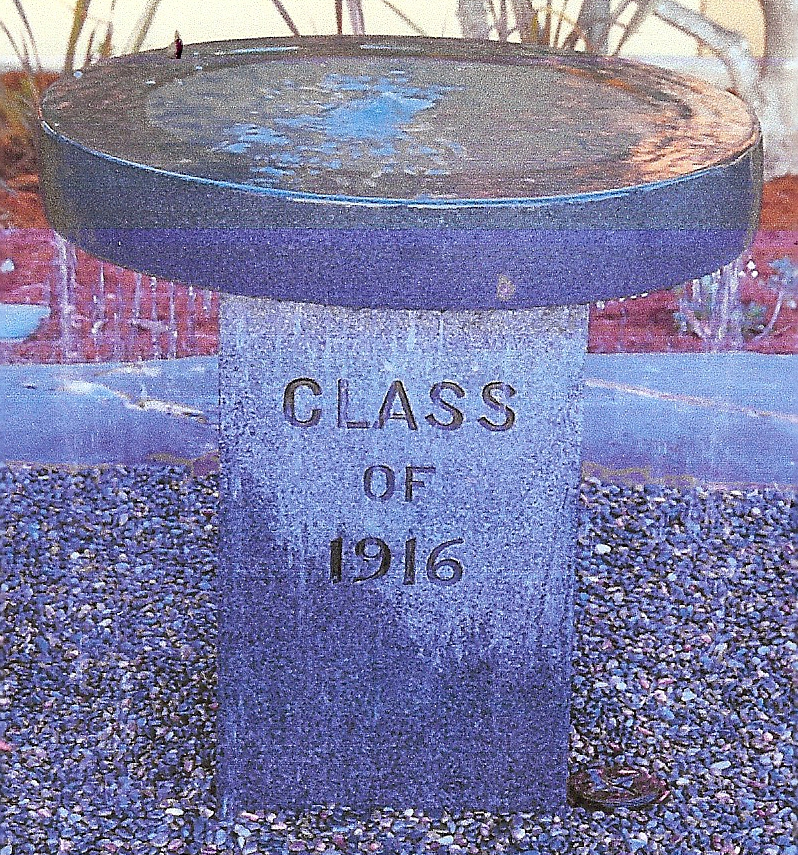
The El Cajon Valley High we know today didn’t open until 1955, when it drew much of the student population from Grossmont, which originally had been home to students from as distant as Pine Valley, 25 miles away, and further east.
The early-century “El Cajon Valley High” is not even a footnote in local prep sports history, but a team with the designation “El Cajon” played games against San Diego High in 1902, 1904, and 1907.
According to Don King, San Diego High historian and author of Caver Conquest, the 1904 game was against the El Cajon Town team. An ensuing contest was noted as being against the community’s high school.
SWEETWATER ON SCHEDULE
Grossmont’s first graduating class numbered 37 students. There were 11 faculty members with an enrollment of about 150 in four grades. A total of 320 students were enrolled when the new campus opened in 1922.
Green and white was chosen as school colors, but they were changed to blue and gold in 1927.
The athletic teams didn’t become known as the Foothllers until 1921, but Grossmont fielded a team this season, under coach J. Howard Becker, and didn’t score a point in four games against schools that became their County League rivals.
One of those opponents was Sweetwater, an emerging South County school Grossmont would play every season through 1960 except 1941 and ’52.
RULES MADE TO BE BROKEN?
The CIF, established in 1913, increasingly found its desired role of friendly, neighborhood cop to 90-plus schools devolving into that of a grouchy high school vice principal in charge of discipline.
The Cavemen’s game at Long Beach triggered a major dispute between the governing body and one of its members.
While 8,000 mostly Jackrabbits faithful (about 300 San Diego supporters made the 4-hour trip north) cheered as their team punctuated the victory with 28 fourth-quarter points, Poly officials received a telegram during the game inviting the team to play Englewood High of Chicago.
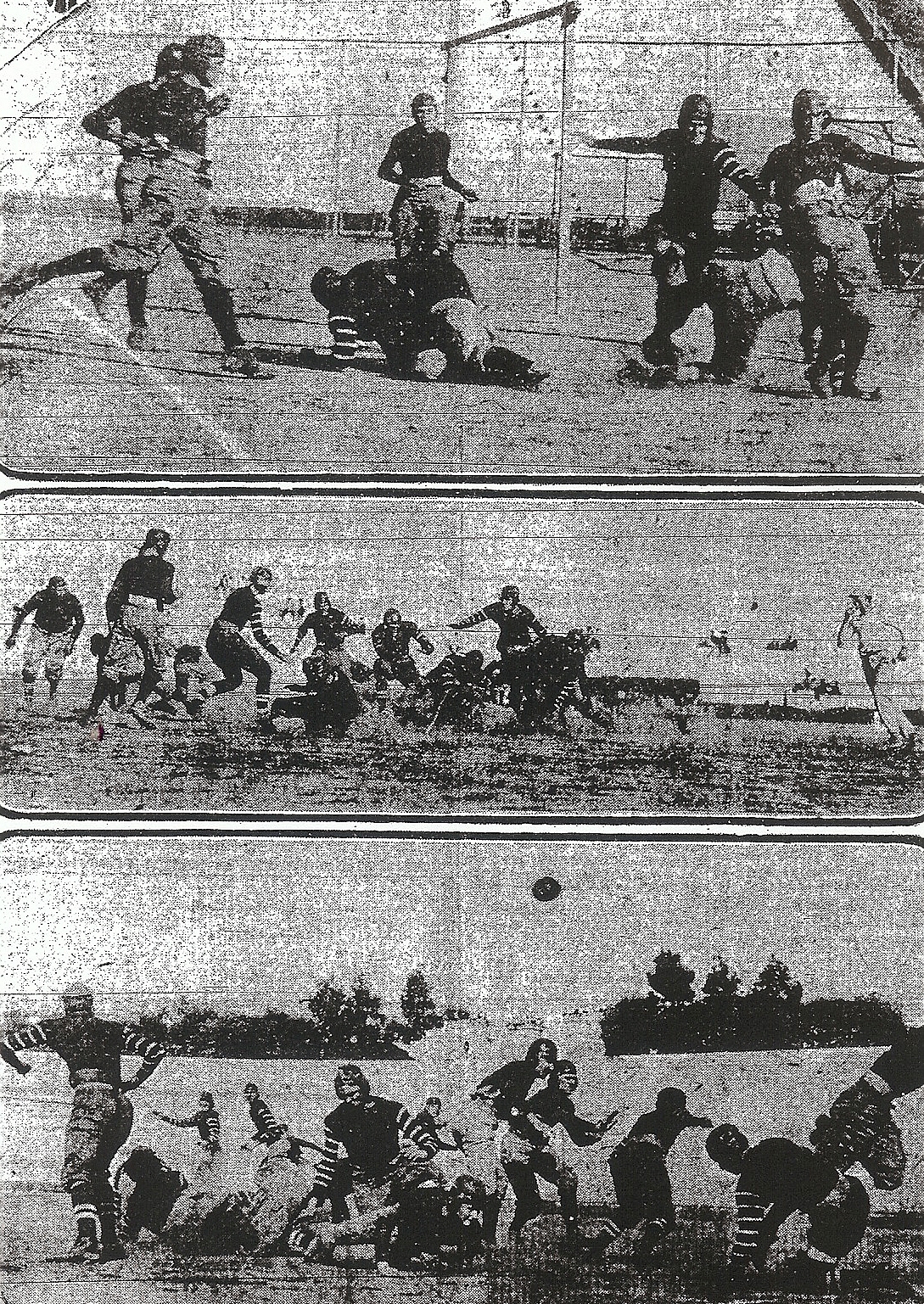
The ambitious Chicago squad wanted to play the coast school for what Englewood officials described as a national championship game on Christmas Day. Poly bosses immediately wired back that they accepted.
NOT SO FAST
CIF secretary Seth Van Patten told Poly administrator Harry J. Moore that Long Beach was required to compete in the 10-team Southern California playoffs and in a possible state title contest.
According to CIF rules, teams were supposed to turn in their gear once they completed play in Southern California or on the state level.
Despite the shellacking, San Diego was a likely semifinals opponent for Long Beach, if the teams won earlier playoffs.
The CIF determined postseason invitations were for schools that had at least three wins over “representative” opponents.
CAVEMEN MEET STANDARD
San Diego had qualified for the postseason after victories over Los Angeles Franklin, Fullerton, and Orange.
The Cavers defeated Van Nuys, 81-0, in a quarterfinals contest on the same day that Long Beach Poly advanced with a 55-0 victory over Los Angeles Poly.
John Perry wanted no part of a second game in Long Beach. Principal Harry Wise told the CIF that San Diego would play the game only at a neutral site, preferably at Pomona, a good distance from the Jackrabbits’ base.
After defeating L.A. Poly, Long Beach gave the CIF the figurative middle finger salute and pulled out of the remainder of the postseason.
The scrambling CIF then gave San Diego a day’s notice that it would play in the semifinals against L.A. Poly, despite the Mechanics’ 0-55 score against Long Beach.
San Diego led most of the game after John Hunter’s 25-yard field goal, but the Mechanics scored a touchdown in the last five minutes to win, 7-3.
L.A. Poly’s reward was a berth in the finals, in which it lost to Santa Monica, 49-0.

HARES OFF EASY
The game with Englewood never was played, but Long Beach accepted another challenge from the high school in Everett, Washington.
The Everett Seagulls defeated the Jackrabbits, 28-7. Poly then won the “championship” of the southwestern united States by defeating Arizona’s Phoenix Union, 102-0.
The CIF followed by announcing that Poly was being “kicked out”. Not suspended, but “kicked out,” no longer a member of the federation.
The punishment didn’t last long. The Jackrabbits were back in the fold for basketball season.
CAVEMEN BASEBALL OUT
But the bumbling CIF wasn’t so easy on the San Diego High baseball team, which defeated Cleveland East Tech in a two-game, “national championship series” the following spring.
The baseball Cavemen were hit with a judgment in the 1921-22 school year, barred from playing against high school teams for one season and suspended from the Southern California playoffs.
UNEVEN OFFICIATING
Local banking executive and football referee Mouney Cassar Pfeffercorn convened a meeting at the First National for representatives from high schools and service football teams.
“There are many football officials here but almost everyone has a different interpretation of a rule,” said Pfeffercorn, who noted that problems were cited by out-of-town teams, which complained that local flag throwers incorrectly interpreted.
Officiating pay generally was $10 for referee and $7.50 each for umpire and linesman. A fourth official, on request, received $5.

Born in Austria in 1883 and a naturalized American citizen since 1908, Pfeffercorn was active on many sporting fronts in San Diego in the first half of the 20th century.
SIGNS OF THE TIME
Robert Clark and Justin Bennett of San Diego will be out of the Franklin game “unless they can dig up more credits”, reported The San Diego Union. The article also said that “Howard Williams, Chalmers McKenzie, and Harold (Hobbs) Adams also are reported behind in their studies and will not play Saturday.”
LARGE STUDENT BODY
Six weeks into the school year, San Diego High listed 2,370 students, making it one of the largest high schools in the country, according to the Evening Tribune.
City elementary schools reported enrollment of 9,000, although daily attendance was at least 1,000 fewer. “An appeal is made to the parents of the city to make the attendance of every child as punctual and regular as possible,” said a City Schools statement.
ARRAY OF ACTIVITY
Football was king but not the only sport at the Grey Castle. A class of beginners in swimming started, a chess club was in competition, and tennis was popular. Girls interscholastic basketball was due to begin.
DON’T BE SO NOSEY
Team captain Lawrence Hall sustained a broken nose before the opening of practice when he dived off the high board at a plunge in Del Mar and struck the bottom of the pool.
Hall was recuperating when he engaged in a medicine ball exercise with a teammate a week later and the ball struck Hall in the face.
Hall sustained a second, rearranged schnozz and was on the sideline for another three weeks.
CORONADO STREAK ENDS
A 21-7 loss to Sweetwater was the first for Coronado against County League competition since a 47-0 defeat by Escondido in 1914. The Islanders had won 16 in a row and not been scored on by their suburban competition.
HONORS
Guard Gordon Thompson and back John Hunter of San Diego made the all-Southern California second team, Long Beach Poly’s Jim Lawson was player of the year.
QUICK KICKS
Missing the Van Nuys playoff with wrist and shoulder injuries cost John Hunter a shot at Bryan (Pesky) Sprott’s school record of 156 points in one season, set in 1916…Hunter played only eight games but had 18 touchdowns, 24 points after, and a field goal for 135 points…Seth Van Patten, a former baseball coach at Escondido, was elected CIF Secretary…John Perry’s idea of giving his San Diego players a respite from the humdrum of practice was a 2 ½-mile “dogtrot” to and from the nearby Golden Hill Playground…Perry admonished his gridders before the Long Beach trip to “play hard but not dirty and do not bet on the game”…San Diego’s 81-0 playoff win over Van Nuys was called in the fourth quarter because of darkness… the Southern Section playoffs would include 10 teams, more than the state’s three other sections: Central (6), North Coast (4), and Northern (4).


